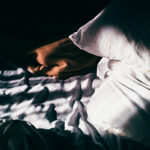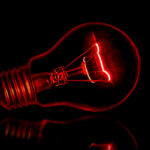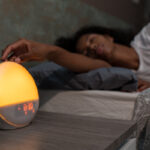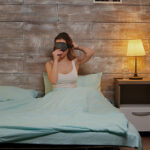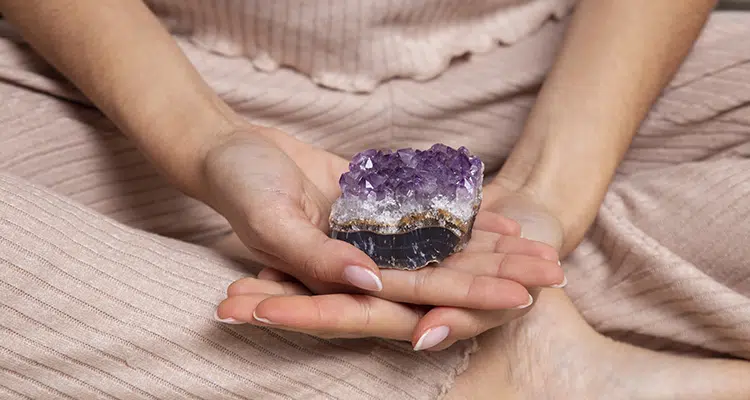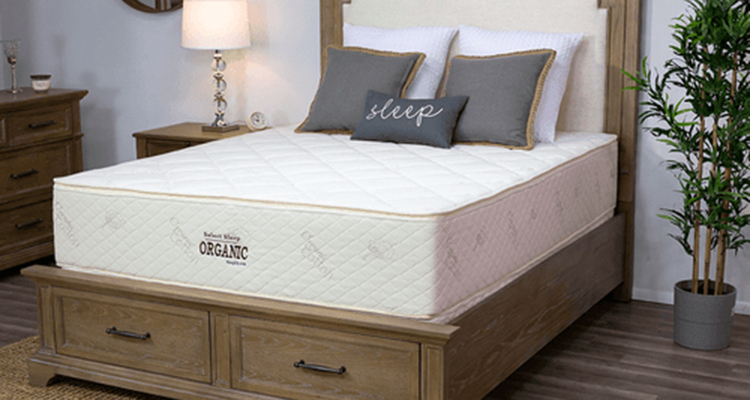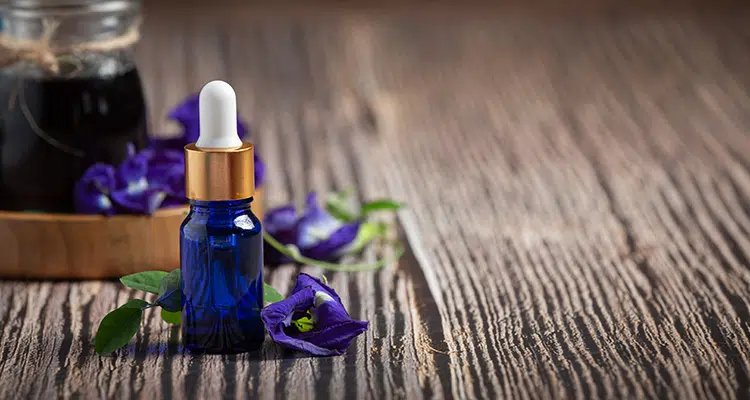Does Red Light Help You Sleep?
Red lights stop traffic but do they also stop you from getting a good night’s sleep? Your brain processes different types of light in different ways. For example, the blue light produced by electronic devices like your smartphone or tablet actually stops melatonin production, making it increasingly difficult to fall asleep at night.
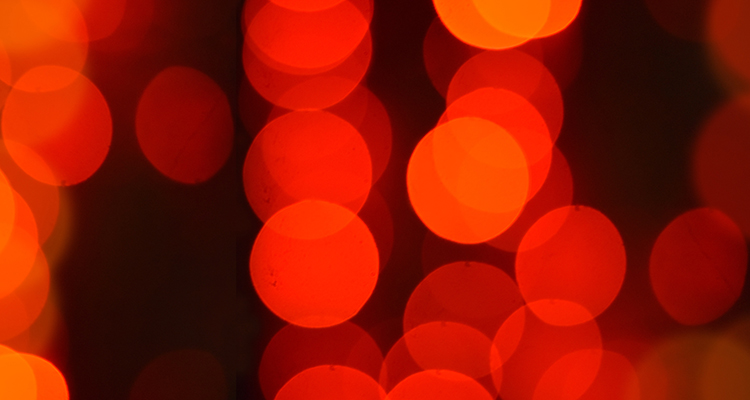
The light you surround yourself with both directly before bed and in the middle of the night (during those late-night bathroom runs) can all impact how well you sleep, how often you wake up, and how easily you fall back asleep.
So, where does red light fall on the spectrum when discussing the best lights for sleep? Keep reading to find out!
Content
The Relationship Between Light and Sleep
Before we reveal whether or not red light hinders or helps your sleep quality, let’s briefly discuss how light, in general, affects sleep. Light has controlled the human body’s internal sleep-wake cycle for centuries. Long before clocks existed, your body naturally became fatigued as the sun went down and darkness set in. Your brain saw darkness as a trigger for sleep, signaling the release of the sleep hormone melatonin. Melatonin is naturally produced in response to darkness and works to help promote relaxation and sleepiness.
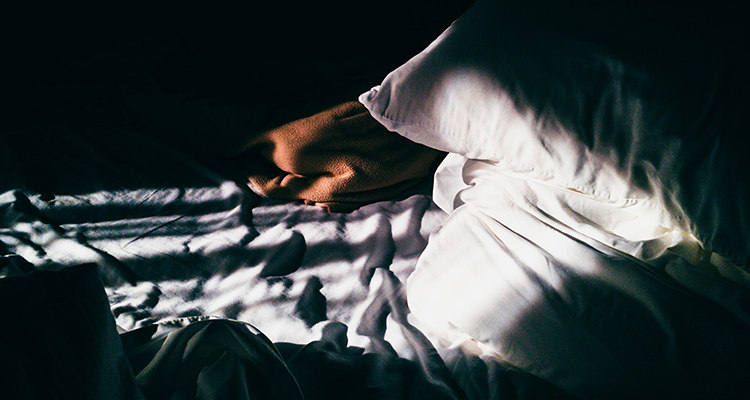
On the contrary, as the sun rises and the outside world becomes bright and alive, so does your body. The human brain recognizes light as a sign that it’s time to wake up and become increasingly aroused. Melatonin levels drop and you slowly begin to feel more alert and ready to tackle the day. This natural cycle of feeling tired at night and feeling more awake in the morning is called your circadian rhythm. Studies show that increased exposure to light during the daytime can facilitate productivity, improve your mood, and help you feel more focused and alert. It may also help you feel more tired and ready for sleep as night falls.
This is also why overexposure to light too close to bedtime (especially blue and green light) can confuse your internal clock, tricking your brain and body into thinking it should be awake instead of asleep. All of these factors can lead to a misaligned circadian rhythm, which creates a vicious cycle of restless or disrupted sleep and daytime drowsiness which may cause you to nap more often during the day or drink large quantities of caffeine – all of which can disrupt your sleep the following night, creating unhealthy and inconsistent sleep patterns.
Does Red Light Help You Sleep?
Now that you understand a little more about how light impacts sleep, let’s talk about colors. It’s already been said that blue light is one of the worst light colors for sleep (more on this below), but how does red stack up when discussing the best light colors for sleep?
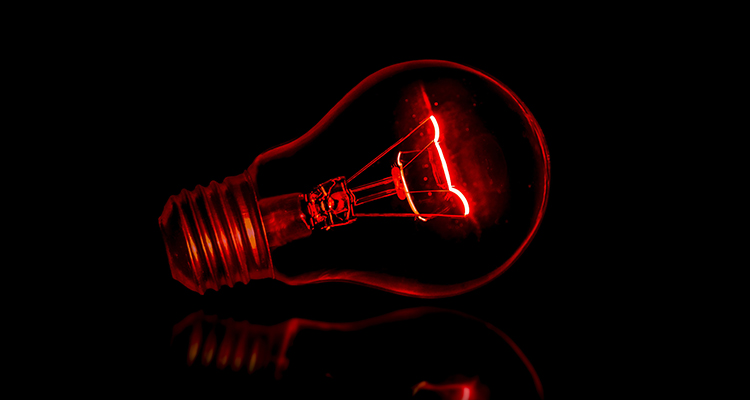
Although complete darkness is recommended for achieving deep, restorative sleep, some people prefer a little light in their bedroom. You may also need a nightlight to safely navigate to the bathroom in the middle of the night. Whether it’s a small bedside lamp or a nightlight in the hallway, red light is actually the most beneficial and least disturbing colored light for sleep.
To understand why red light promotes healthy sleep habits, you have to know a little more about how your brain and eyes process different light wavelengths. Simply replacing your current light bulbs with ones that are tinted red isn’t enough. You need to invest in bulbs that emit red light wavelengths. These bulbs are specifically designed not to emit any blue or green light. They also shine slightly dimmer than other lights, producing a soft, mellow glow that provides enough illumination to safely move around without stimulating your senses. Research suggests that exposure to red light during the night makes it easier to fall back asleep. Turning on harsh white lights or even briefly checking your cell phone in the middle of the night can interfere with your ability to fall back asleep due to their short wavelengths.
According to science, light wavelengths are measured in nanometers (nm). The light that’s visible to the naked eye ranges from 380 nm, which includes purple light, up to 780 nm which is red light. It’s believed that short wavelengths in the range of 380 nm to around 500 nm suppress the natural release of melatonin, whereas longer wavelengths of 500 nm and above (including red light) may actually increase melatonin production, promoting better sleep and causing less sleep disturbances.
A small study conducted on a group of 20 female athletes indicated that those participants who received red light exposure for 30 minutes every night for 2 weeks showed an increase in melatonin levels, sleep quality, and endurance during daily activities and exercise. Another 2019 study held in an office building concluded that a combination of red and white light exposure for employees increased participants’ alertness and improved their circadian rhythm in the afternoon hours, which is usually when most people experience a dip in energy levels.
Red Light and Sleep Inertia
Sleep inertia is the groggy feeling you experience directly after waking up in the morning, as your body transitions from being asleep to being awake. Sleep inertia can impact your alertness, focus, short-term memory, and overall performance. A study conducted on the effects of sleep inertia showed that patients exposed to red light delivered through closed eyelids experienced less grogginess and felt increasingly more alert, more quickly after waking up.
Red Light and Night Vision
If you’ve ever been blinded by another vehicle’s headlights while driving, you know that bright white lights can cause you to squint and make it increasingly difficult to see at night. Red light, on the other hand, is much softer and doesn’t cause this same harsh glare. This is one reason why submarines, airplane cockpits, and certain commercial vehicles are equipped with red lights on the dashboard. Even astronomers are known to carry red flashlights versus white ones.
A Brief Look at Other Light Colors for Sleep
Many colors exist between stimulating blue lights and mellow red lights. Here’s a brief look at a few other light colors that can either hinder or help you get a good night’s sleep.
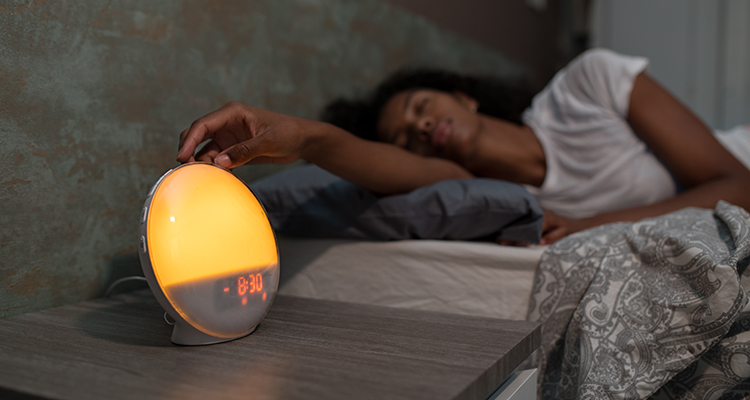
Amber
Considering amber is a lighter version of red, it should come as no surprise that amber lights come in at a close second when discussing the best light colors for sleep. Amber light wavelengths are made up of 75% yellow and 25% red and are believed to deliver a calm, soothing glow that some people consider less harsh than strictly red light. In addition to facilitating sleep, amber light can reduce anxiety, promote melatonin production, trigger feelings of calm and relaxation, and improve your overall mood before bed. Amber light is on the same wavelength as the light produced by a soothing candle, which may ease anxious thoughts and make it easier to fall asleep.
Not only can amber light facilitate sleep but it’s also designed to block out harsh blue and green light that can disrupt sleep and melatonin production. By replacing traditional light bulbs with amber-colored ones, you can reduce how much blue light your eyes absorb during the daytime, which may lead to a better night’s sleep. The best part is, amber light bulbs give off enough light for you to perform daily tasks without squinting or straining your eyes.
Blue and Green
While blue light has always gotten a bad rap as the worst color for sleeping, green comes in at a pretty close second. But it’s important to note that any light that’s too bright or shining directly in your face at night can be distracting and make it difficult to fall and stay asleep. With that being said, even the blue and green light you’re exposed to during the day can negatively impact how well you sleep at night.
Blue and green light signals your brain that it’s time to wake up, halting melatonin production. Even brief exposure to these lights in the middle of the night can make it seemingly impossible to fall back asleep. While most people know that electronic devices and screens emit these wavelengths, other popular sources of blue and green light include fluorescent lights and LED light bulbs. While the latter may be more energy efficient for your electrical bill, LED lights may be wreaking havoc on your sleep. Wearing blue light-blocking glasses when looking at screens and reducing exposure to these light sources during the day can help counteract these negative effects.
Tips for Using Red Light to Improve Sleep
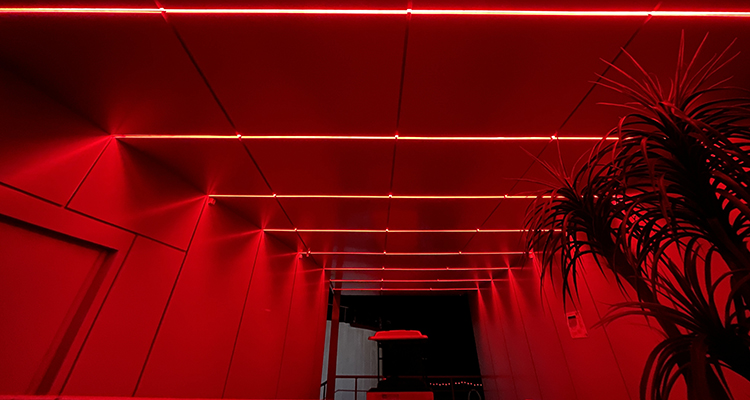
Now that you know red light promotes quality sleep above all other colors, here are a few tips for incorporating red wavelength bulbs into your home, workspace, and daily life.
- Swap out LED light bulbs with red or amber bulbs
- Reduce time spent in harsh overhead fluorescent lights like those found in many offices and workspaces
- Invest in blue-light-blocking glasses
- Use dim red or amber nightlights in your bathroom, hallway, living room, and other areas of the house to light the way at night without disturbing your sleep
- Incorporate warm lighting into your living space to promote calm, relaxation, and peace
- Invest in light bulbs, lamps, chandeliers, and nightlights that emit red wavelengths and aren’t just red in color
- Avoid all light exposure at night to make it easier to fall and stay asleep
- Consider red light therapy
What is Red Light Therapy and How Does it Work?
As people search for easier and more effective ways of combating insomnia and overcoming other common sleep disorders, light therapy is growing in popularity. This holistic and non-invasive form of therapy uses light in different colors and wavelengths to increase arousal and focus during the day and promote quality sleep at night. Light therapy is used in varying degrees, depending on the patient’s specific sleep issues.
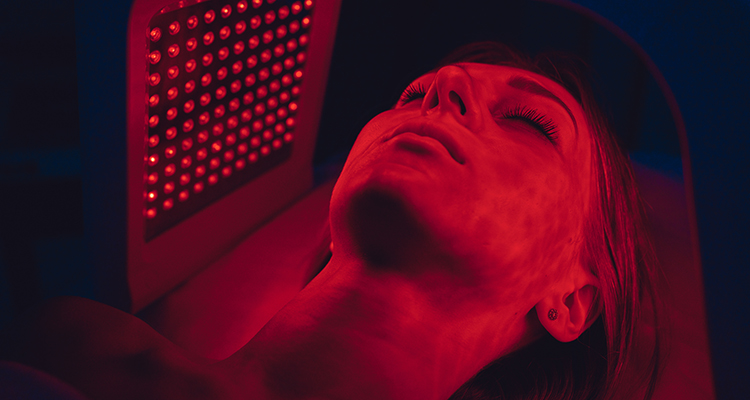
Red light therapy uses visible light with wavelengths between 620 nanometers and 700 nanometers. These wavelengths are shorter than blue light and harmful UV light and penetrate the skin more easily and deeply. This produces positive effects on a cellular level. Some of the benefits of red light therapy (in addition to improved sleep) include pain reduction, easing inflammation, and healing damaged tissues and cells. Red light therapy has also been linked to helping mitigate hair loss, aid in muscle recovery, and soothe certain skin conditions.
By easing the symptoms associated with these above-mentioned conditions, some patients find it easier to fall and stay asleep. For example, easing pain in chronic pain sufferers can reduce the occurrence of nighttime awakenings and make it easier to achieve a comfortable sleep position. Speeding up muscle recovery and the healing process also reduces pain and discomfort at night often associated with lack of sleep, disrupted sleep, and trouble falling asleep.
More research is being done on red light therapy and the use of red lights to help promote sleep, but many of these studies and patient reports suggest incorporating red lights into your life can improve sleep quality and counteract the negative effects of certain sleep disorders.
Red Light Can’t Replace Good Sleep Habits
As beneficial as red light can be, swapping your current light bulbs and light fixtures for red and amber ones isn’t going to solve all of your sleep problems. Using red light can help promote better sleep but it’s not a replacement for healthy sleep habits.
Here are several simple lifestyle changes to consider in addition to utilizing the benefits of red light for sleep.
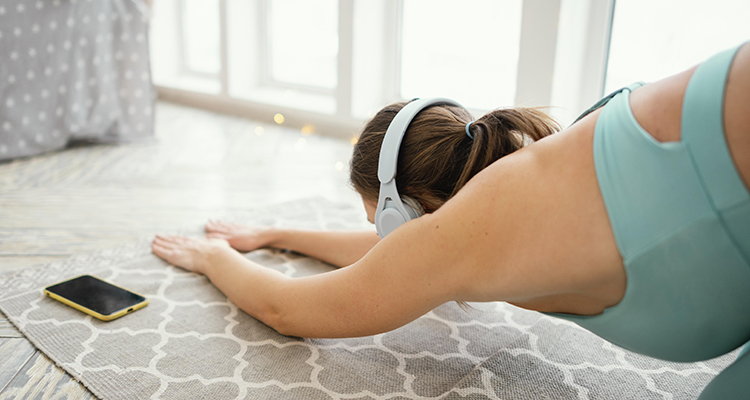
Create the Ideal Sleep Environment
Your bedroom should be an oasis for sleep – free from clutter, stress, and external distractions. Achieving this is sometimes easier said than done. Start by blocking out noise and light disturbances using things like sleep headphones or a sound machine and room darkening shades. Here’s where a dim amber or red night light will come in handy! Use a warm, soothing light to illuminate your bedroom slightly and create a cozy and inviting space.
Those clothes thrown on your floor and paperwork all over your dresser are doing more than just creating an eyesore. Did you know that a cluttered or messy bedroom can negatively affect your sleep by triggering feelings of anxiety and stress? Just seeing these items out of place can make you feel uptight and overwhelmed. Keep your bedroom neat and organized with everything in its place.
The bed you sleep on and in also matters. Invest in a high-quality mattress and pillows that offer the support you need. The sheets and blankets you use should also be a quality, breathable fabric to help keep your core temperature cool. Not only does this prevent night sweats and frequent awakenings but studies show, the cooler your body temperature is, the better you’ll sleep.
Adopt a Relaxing Bedtime Routine
Everything you do from the moment you wake up in the morning until you get into bed at night can either help or hurt your sleep quality. By adopting a healthy winddown routine leading up to bedtime, you can help your body create a predictable routine that reduces stress and promotes good sleep.
Put down your cell phone, turn off the TV, shut off your video game console, and close your laptop at least 60 to 90 minutes before bed so your brain can naturally start producing and releasing melatonin. Next, adopt a relaxing activity you enjoy like reading from a book (no tablets!), meditating, performing yoga, taking a soothing bath, listening to soft music, or drinking a hot cup of chamomile tea.
Try performing these activities at the same time each night. Before long, your body will recognize these behaviors as cues for sleep. When you start to perform them and the sun starts to set, your body will naturally start preparing for sleep and you may find yourself getting increasingly tired. This also promotes a healthy, balanced circadian rhythm.
Set a Sleep Schedule
Performing the same healthy habits at night isn’t the only way to align your circadian rhythm. Setting a sleep schedule that involves going to bed and waking up at the same time every day is the most effective way to balance your sleep-wake cycle. Give yourself a bedtime at night (even on the weekends) and set an alarm for the morning. Ensure that the time frame you choose allows for at least 7 to 9 hours of sleep. By following this schedule consistently, your body will automatically start to release melatonin as it nears your set bedtime. You may also find yourself waking up in the morning without the need for an alarm.
Increase Light Exposure and Physical Activity in the Morning
Increasing light exposure during the daytime hours can improve mental focus, boost your mood, and increase productivity. It’s also believed that light exposure can help you feel more alert and aroused. Natural sunlight is especially beneficial thanks to its high concentration of vitamin D – another essential nutrient for quality sleep. Try taking a walk outside in the morning or on your lunch break. Light exposure combined with physical activity early in the day can help you feel more tired and prepared for sleep at night.
Shed Some Light on Your Sleep Troubles
One in three adults worldwide suffers from some type of insomnia or reports difficulty sleeping at least a few nights per month. Inconsistent work schedules, increased stress, and unhealthy sleep habits can all lead to poor sleep quality. Chronic sleep deprivation puts you at an increased risk of myriad other health issues. Your mental and physical well-being starts with a good night’s sleep.
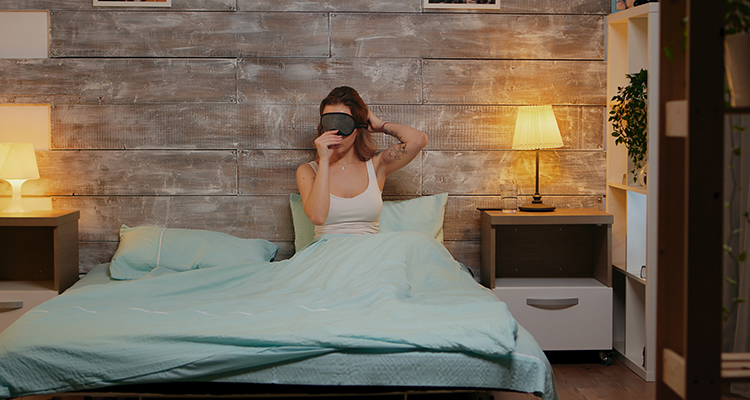
Utilizing the benefits of red light and reducing blue light exposure is one simple way to reduce sleep disturbances and support healthy sleep habits. Others include setting a sleep schedule, avoiding stimulating activities too close to bedtime, and creating a positive sleep environment. All of these techniques are utilized in cognitive behavioral therapy for insomnia (CBT-i). CBT-i is designed to help identify the underlying cause of your sleep troubles and improve your relationship with sleep. Learn more here.

